The following paper was researched, written, and presented as a public lecture by Carolina McGarity ’17, the museum’s 2014-2015 Robert F. Reiff Curatorial Intern.
Introduction
In his Portrait of a Man, [fig. 1] Govaert Flinck uses very Rembrandtesque elements and style. One such element is chiaroscuro, or the dramatic use of light and shadow to heighten the sense of drama. The portrait is generally dark, especially in the solid background and in the garments worn by the sitter. The sitter’s complexion, illuminated by the light, is very fair with ruddy cheeks, and his hair is curly and red. He has a wispy mustache and a thin white scarf. As in many of Rembrandt’s self-portraits, Flinck’s sitter is wearing a beret.
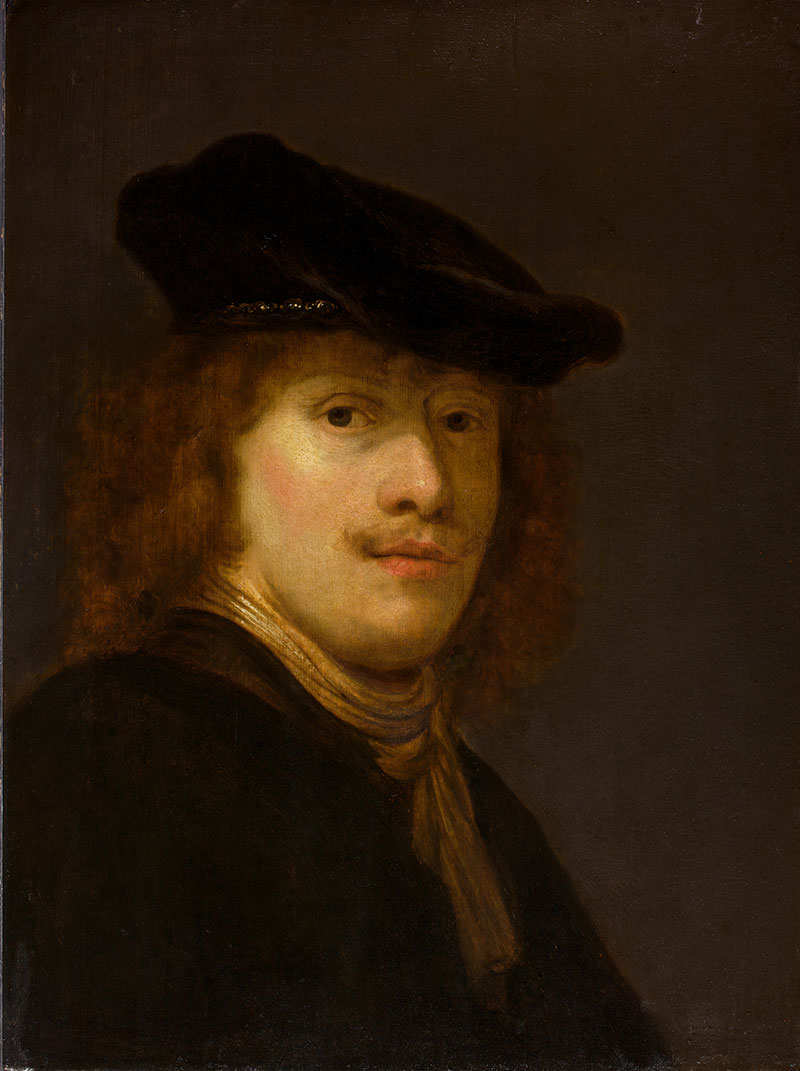
Portrait of a Man by Govaert Flinck raises many questions. It is made in the style of the Rembrandt workshop, and because of that it brings with it a tangle of complexity and a long background of connoisseurship. I will discuss three options for who the unidentified sitter might be: either Flinck is painting himself, Rembrandt, or another unidentified person. Rembrandt van Rijn’s workshop has been an area of great interest for connoisseurs, especially in the past forty years. His studio practice makes the attribution of Rembrandtesque paintings very difficult, as Rembrandt taught his students to paint in his style, and marketed all the workshop paintings as his own. This has led to much controversy among connoisseurs, especially among members of the Rembrandt Research Project, a group that seeks to organize and categorize research on Rembrandt in order to discover new facts, and which has become the leading authority on determining Rembrandt’s genuine oeuvre.
Through the comparison of paintings by Flinck, Rembrandt, and other workshop assistants, I will argue that Flinck painted his Portrait of a Man while in Rembrandt’s workshop, and that it was likely a self portrait. I will begin by explaining the function of the Rembrandt Studio and its inherent complexity, and then analyze Flinck’s portrait on technical, stylistic, and facial-characteristic terms in order to draw the connections that lead to my conclusions.
Rembrandt’s Workshop: An Enterprise for the Rembrandt Style
The Rembrandt School has concerned art historians and connoisseurs for many years because of the difficulty of determining the authenticity and authorship of its paintings.[ref]Joachim Wolfgang, giat von Moltke, Govaert Flinck: 1615-1660 (Amsterdam: Menno Hertzberger & Co: 1965), 9.[/ref] As famously argued by Svetlana Alpers, Rembrandt ran his studio as an “enterprise,” in which he taught his students to paint convincingly in his style.[ref]Svetlana Alpers, Rembrandt’s Enterprise (Chicago: The University of Chicago Press, 1988), 69.[/ref] In this way, he was able to disseminate his style widely and meet the demand for his paintings. We do not have any direct knowledge of the workshop, but instead have colorful reports from contemporaries and sometimes misleading evidence from paintings.[ref]Walter Liedtke, Rembrandt’s “Workshop” Revisited (Oud Holland, Jaarg. 117, No. 1/2: 2004), 48.[/ref] A common if mistaken view of Rembrandt’s workshop is that of a small training institute where Rembrandt was a solitary painter who created his own production completely separately from his students.[ref]A Corpus of Rembrandt Paintings II. (Stichting Foundation Rembrandt Research Project, 2005), 51.[/ref] This misleading conception of the function of the workshop has created misunderstandings about the making of the Rembrandt oeuvre. Evidence shows that in fact the workshop was more of an art factory for works of the master, an enterprise to market and meet the high demands of the style. This “enterprise” type of workshop and notion of art was successful because of Rembrandt’s mastery of studio production and the establishment of value for his style within the marketplace.[ref]Alpers, Rembrandt’s Enterprise, 11-13.[/ref] Instead of merely working as a craftsman, Rembrandt also sold his products as an entrepreneur, working with the market to create a demand for his distinct style.[ref]Ibid., 101.[/ref] He did this by creating self-portraits as calling cards for buyers, who wanted to own a picture of the master, as well as the masterpiece.[ref]Kevin Sullivan, Out of the Shadows (Documentary, Sullivan Entertainment, 2012).[/ref] These pieces showed the artist’s likeness and also displayed his skills in painting, thus acting as an advertisement for the painter and his craft.
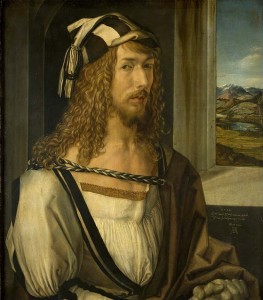
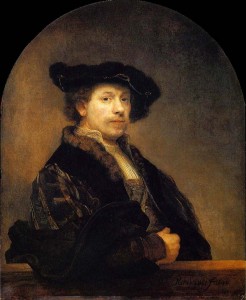
By painting himself, and sometimes in the costume of earlier painters’ self-portraits, Rembrandt placed himself within a long tradition of self-portraiture. There was already a growing fascination with self-portraiture in the Renaissance,[ref]Volker Manuth, trans. Rachel Esner, “Rembrandt and the Artist’s Self Portrait: Tradition and Reception,” in Rembrandt by Himself, ed. Christopher White and Quentin Buvelot, 41.[/ref] evidence of the developing interest in the personality of the artist as well as a way of heightening the status of the artistic profession.[ref]Ibid., 56.[/ref] Rembrandt turned to the 15th and 16th centuries for models of self-portraits, referencing heavily artists such as Titian and Dürer.[ref]Ibid., 44.[/ref] Albrecht Dürer’s Self-Portrait of 1498 [fig. 3] clearly served as a reference for Rembrandt’s Self Portrait at the Age of 34 [fig. 2]. Dürer’s portrait is quite a bit smaller, measuring 53 x 41cm compared to Rembrandt’s portrait of 92 x 76 cm. The compositions are very similar, with the figures placed slightly to the left of center in three-quarter view, making eye contact with the viewer. The arm of each sitter rests fully on a window sill, suggesting that the frame through which we see the painting is in fact a window. Rembrandt is dressed in slightly different clothing from Dürer, yet he too wears a hat and loose, expensive-looking garments that are suggestive of a costume. Rembrandt was aware that he was part of a great tradition of artistic self-portraiture, and he clearly references precedents for his portraits.[ref]Ibid., 56.[/ref] Thus his self-portraits were both situated and marketed within a historical precedent that helped to create the conditions for his enterprise to become popular: he created self-portraits, which were an already-popular genre, and he disseminated his likeness, so buyers knew who he was, while also advertising his style and creating a demand for it. This strategy worked well, as it is clear that Rembrandt’s self-portraits were desirable collectors’ items.[ref]Ibid., 51.[/ref] They were accumulated in princely collections such as those of King Charles I,[ref]Ibid, 46.[/ref] and non-princely collections such as those of Marten van den Broeck of Amsterdam.[ref]Ibid., 50.[/ref] By training his students to paint convincingly like himself, Rembrandt was able to keep up with the demand for his work.
Rembrandt’s students played a crucial role in driving his version of a workshop and, ultimately, in the success and wide dissemination of Rembrandt’s artistic popularity and influence. Due to the extent of Rembrandt’s collaboration with and transmission of style to his students, he made his enterprise—and the creation of the Rembrandt painting as a commodity—possible. Rembrandt chose the life of a teacher, dedicated to cultivating his style in his students; he “engendered, nurtured, and sold the Rembrandt mode to the Dutch Republic.”[ref]Alpers, Rembrandt’s Enterprise, 59.[/ref] From the available sources we can glean that he was a good teacher as well, and that he enjoyed teaching. He trained many pupils, many of whom went on to be masters.[ref]W.R. Valentiner, Rembrandt and His Pupils, (Raleigh: The North Carolina Museum of Art, 1956), 22.[/ref] His students facilitated the establishment of “the Rembrandt” brand because they allowed the workshop pieces to be disseminated in both quantity and speed.[ref]A Corpus of Rembrandt Paintings III (Stichting Foundation Rembrandt Research Project, 2005) 12.[/ref] It is also fairly clear that Rembrandt’s pupils carried out commissioned portraits. Specifically, there is evidence that Flinck completed portrait commissions, as he also did for Rembrandt’s landlord Hendrick van Uylenburgh. But even more surprising is the fact that Rembrandt also let his students paint the faces in these portraits, which was an uncommon those days.[ref]Ibid., 30-31.[/ref] Though his students were called “pupils,” they were really more like studio assistants due to their artistic capacity and the extent of their collaboration.[ref]A Corpus of Rembrandt Paintings II, 45.[/ref] Thus the function of Rembrandt’s workshop can be characterized as an ambiguous, reproductive process.[ref]Walter Liedtke et al. Rembrandt / Not Rembrandt in the Metropolitan Museum of Art: Aspects of Connoisseurship (Volume II – Paintings, Drawings, and Prints: Art-Historical Perspectives). (New York: The Metropolitan Museum of Art, 1995), 48.[/ref] Much of Rembrandt’s success as a painter was owed to the fact that he taught his students to copy his own style, for both practice and for sale.[ref]Valentiner, Rembrandt and His Pupils, 25.[/ref]
Rembrandt’s entrepreneurial workshop organization remains somewhat of a mystery in terms of who all the assistants were and which pieces they worked on, as it is almost impossible to distinguish and identify all the varying artistic hands.[ref]Alpers, Rembrandt’s Enterprise, 101.[/ref] This is different from other workshops at the time, like those of Rubens or Honthorst, which were either large production systems with divisions of responsibility, or smaller ones with less specialized staff collaborating on large projects.[ref]Liedtke et al. Rembrandt / Not Rembrandt in the Metropolitan Museum of Art: Aspects of Connoisseurship, 48-49.[/ref] The clearer workshop organization made it easier to distinguish authorship, especially of that master. There is much discussion on how much “collaboration” went on between Rembrandt and his pupils.[ref]Ibid., 55.[/ref] Some sources deny that there was any collaboration at all, but works such as the etching “Ecce homo” (1635-36) clearly show two hands.[ref]A Corpus of Rembrandt Paintings II, 61.[/ref] We do know that students often based their techniques and compositions on sketches made by Rembrandt, so in that sense there was collaboration.[ref]J. Bruyn, An Unknown Assistant in Rembrandt’s Workshop in the Early 1660s. (The Burlington Magazine, Vol. 132, No. 1051. October, 1990), 716.[/ref] It is certain, however, that Rembrandt’s students copied many of his works deliberately from his prototype.[ref]A Corpus of Rembrandt Paintings III, 19-20.[/ref] Yet these were not really copies per se, but rather more like duplicates and studies with variants in figure, costume, illumination and the like.[ref]A Corpus of Rembrandt Paintings IV (Stichting Foundation Rembrandt Research Project, 2005), 89.[/ref] The reason students did this was two-fold: to learn by studying Rembrandt’s past works,[ref]Alpers, Rembrandt’s Enterprise, 84.[/ref] and to help keep up with the demand for Rembrandts.[ref]A Corpus of Rembrandt Paintings IV, 143-144.[/ref]
Rembrandt did not separate art as a commodity from himself personally. Because he had his portrait duplicated by his students and signed with his autograph, he presented all studio and personal work as an extension of himself.[ref]Alpers, Rembrandt’s Enterprise, 101-102.[/ref] In this way, Rembrandt can be seen as an entrepreneur of the self, yet simultaneously encouraging its replication.[ref]Ibid., 118-119.[/ref] His many portraits were an extension of a type, and the copies of those portraits were a diffusion of the self.[ref]Ibid., 120.[/ref] To reference Alpers’s argument, Rembrandt’s enterprise could be seen as ironic since he had the brilliant ability to imbue his works with an aura of individuality while yet marketing them through duplication and an astute entrepreneurial understanding.[ref]Catherine B. Scallen, Rembrandt, Reputation, and the Practice of Connoisseurship, (Amsterdam: Amsterdam University Press, 2004), 327.[/ref] This deft and vast diffusion of the “Rembrandt” as a commodity was unique in its time to Rembrandt.[ref]Alpers, Rembrandt’s Enterprise, 59.[/ref] Thus the question arises, since the “Rembrandt style” was his enterprise, whether it was reducible to his autographic oeuvre or whether Rembrandtesque paintings made in the artist’s studio should be considered Rembrandts in the same way?[ref]Ibid., 121.[/ref]
The practice of Rembrandt’s studio has created a multiplicity of problems of attribution, due to the conception and execution of different hands and the trouble differentiating between them.[ref]Ernst van der Wetering, Connoisseurship and Rembrandt’s Paintings (Burlington Magazine: February 2008), XVII.[/ref] In addition, as was the law in Holland at the time, pupils were prohibited from signing their studio works with their own names, and thus all studio works bore Rembrandt’s written autograph.[ref]Timothy Cole, Old Dutch Masters: Govaert Flinck, (Century Magazine, Volume 49, Issue 3: January, 1895).[/ref] Because of this law, Rembrandt made considerable money from his apprentices’ work,[ref]Josua Bruyn, “Rembrandt’s Workshop – Function and Production,” in Rembrandt: The Master & His Workshop, ed. Christopher Brown et al (London: Yale University Press. 1992), 69.[/ref] both through the apprenticeship premium and by selling their work.[ref]A Corpus of Rembrandt Paintings II, 54-55.[/ref] Thus, especially in the case of Rembrandt, his name as author was used to cover a widely varied collection. [Corpus I, p. 35]
Govaert Flinck: His Life and Work
One of Rembrandt’s most accomplished apprentices was Govaert Flinck, who managed not only to adopt Rembrandt’s style with a high degree of accuracy, but who also became a very successful master painter on his own after leaving the studio. Flinck, who lived from 1615 to 1660,[ref]Liedtke, Rembrandt / Not Rembrandt in the Metropolitan Museum of Art: Aspects of Connoisseurship, 68.[/ref] was born in Cleves in the Lower Rhine as the son of a merchant. His father wanted him to become a silk merchant, but Flinck had no interest and spent all his free time sketching. Even after his father forbade this activity, Flinck continued to do it in secret. However, Lambert Jakobsz, a family friend and Mennonite preacher, convinced the father that art was a respectable career and took Flinck on as an apprentice in Leeuwarden at the age of 14, c. 1629-1635.[ref]Moltke, Govaert Flinck: 1615-1660, 9-10.[/ref] By the time Flinck left Jacobsz’s studio, he was probably already a fully-trained painter.[ref]Bruyn, “Rembrandt’s Workshop – Function and Production,” 69.[/ref] Flinck was one of Rembrandt’s earliest pupils,[ref]T. Cole, Govaert Flinck (1615-1660) (Century Illustrated Magazine (1881-1906) Jan. 1895: 412. American Periodicals: February: 2015), 412.[/ref] as well as one of Rembrandt’s most gifted ones.[ref]Liedtke, Rembrandt / Not Rembrandt in the Metropolitan Museum of Art: Aspects of Connoisseurship, 58.[/ref] He apprenticed with Rembrandt for about a year, from roughly 1635 to 1636, at the age of twenty.[ref]Peter Schatborn, The Early, Rembrandtesque Drawings of Govaert Flinck (Master Drawings: 2010), 5.[/ref] Like the other pupils, Flinck decided to apprentice with Rembrandt because his “manner was widely praised”[ref]Walter Liedtke et al., Rembrandt / Not Rembrandt in the Metropolitan Museum of Art: Aspects of Connoisseurship (Volume II) (New York: The Metropolitan Museum of Art, 1995), 17.[/ref] at the time. Flinck learned Rembrandt’s style well and quickly, as he was an excellent portrait painter and very receptive to learning new styles in order to follow the market.[ref]Ibid.[/ref] This is why several of his portraits were attributed to his master, and it is difficult to differentiate between the two painters.[ref]Valentiner, Rembrandt and His Pupils, 30.[/ref] Flinck was able to render the sprezzatura, or elegant carelessness, of the brushwork and the sitter’s expressions just as Rembrandt did. He captured the texture of the clothing, the waxy translucence of the skin, and the play of light and dark shadow, all in a manner hardly distinguishable from Rembrandt’s. In the studio, as Flinck was one of Rembrandt’s best “assistants,” he was likely left as the master painter in Rembrandt’s absence.[ref]Liedtke, Rembrandt’s “Workshop” Revisited, 61.[/ref] There is even evidence that Flinck helped Rembrandt with important paintings, Abraham’s Sacrifice, for example.[ref]Moltke, Govaert Flinck: 1615-1660, 13.[/ref] Even though Flinck was eight years younger than Rembrandt, they enjoyed a close friendship[ref]Cole, Govaert Flinck (1615-1660), 412.[/ref] that lasted about five years.[ref]Moltke, Govaert Flinck: 1615-1660, 26.[/ref]
However, Flinck did not remain a follower of Rembrandt forever. In fact, he went on to develop a markedly different style that followed the shifting tastes of the aristocracy. Flinck became an independent master by the age of 21, as shown by his 1636 painting “Pyrrhus.”[ref]Cole, Govaert Flinck (1615-1660), 412.[/ref] Like some of Rembrandt’s other pupils, Flinck continued for a while to work in the Rembrandtesque style and use Rembrandt’s works as models for portraits, landscapes, and history paintings.[ref]A Corpus of Rembrandt Paintings III, 23.[/ref] His break with Rembrandtesque elements did not manifest itself until the mid-forties, though there were preceding signs.[ref]Moltke, Govaert Flinck: 1615-1660, 25.[/ref] Likewise, the parting of his friendship with Rembrandt came gradually, but not unexpectedly, between 1643 and 1645.[ref]Ibid., 27.[/ref] Thus, 1642-1643 can be regarded as the turning point in Flinck’s artistic career,[ref]Ibid.[/ref] as Flinck turned away from the Rembrandt style which he had mastered, to a new style which would bring him numerous patrons, considerable income, and a high level of popularity.
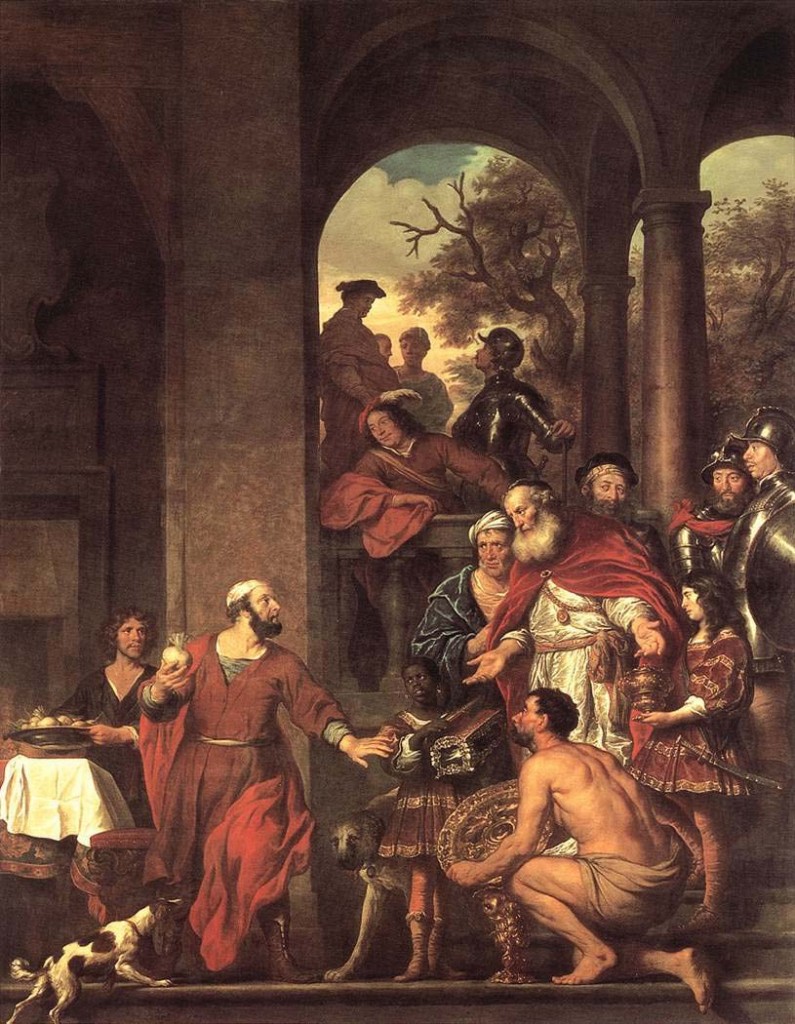
As Rembrandt’s popularity began to wane, Flinck was gradually becoming better known in the circles of wealthy patrons, many of whom would support Flinck in the 1640s. He received many commissions for all genres of paintings.[ref]Ibid. 10.[/ref] Flinck’s new style, known as the Flemish Academic,[ref]Gregory Martin, Review of Govaert Flinck 1615-1660 by J. W. von Moltke (The Burlington Magazine, Vol. 108, No. 765: December, 1966), 638-639.[/ref] first appeared among the Amsterdam cosmopolitan society[ref]Ibid., 27.[/ref] and was characterized by its fluid handling of the brush, its use of a bright color scheme, and its incorporation of pastoral elements.[ref]Sotheby’s, “Govert Flinck,” Old Master Paintings, accessed 4/24/15, http://www.sothebys.com/en/auctions/ecatalogue/2007/old-master-paintings-am1027/lot.73.html.[/ref] One example of this style can be seen in Flinck’s 1656 Curious Dentatus Preferring Turnips to Gold. [fig. 4] To cater to this new market, Flinck adapted to the new style[ref]Schatborn, The Early, Rembrandtesque Drawings of Govaert Flinck (Master Drawings: 2010), 6.[/ref] and became the leading painter of the Flemish Academic manner in Amsterdam during the 1640s and 1650s.[ref]Martin, Review of Govaert Flinck 1615-1660 by J. W. von Moltke, 638-639.[/ref] Flinck went on to have his own studio, also with assistants and apprentices.[ref]Liedtke, Rembrandt’s “Workshop” Revisited, 53.[/ref] He died in 1666 after 25 years as a painter. However, by that time his style was completely transformed, as he had morphed from a Rembrandtesque painter to a “fashionable society painter.”[ref]Moltke, Govaert Flinck: 1615-1660, 10.[/ref] He died at the height of his fame as a popular Amsterdam artist.[ref]Ibid., 11-12.[/ref]
Govaert Flinck: Portrait of a Man
It is not surprising that Flinck’s Portrait of a Man bears remarkable similarity to Rembrandt’s self portraits. Many of Flinck’s paintings have over the years changed in attribution from Rembrandt to Flinck, as will be discussed later. It is obvious from Finck’s signed works that he was particularly able to absorb Rembrandt’s style, and that he had intimate knowledge of Rembrandt’s manner of working.[ref]A Corpus of Rembrandt Paintings II, 88.[/ref] Thus, he had the ability to produce stunningly Rembrandtesque paintings, especially portraits. Flinck was most highly regarded as a portrait painter than in any other genre because of the likeness of the sitter that he was able to achieve.[ref]Ibid., 89.[/ref]
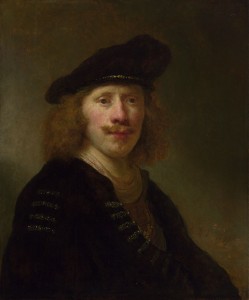
A comparison of stylistic and technical details in Rembrandt and Flinck paintings illustrates the strong similarity between their works and the extent to which Flinck adopted Rembrandt’s style. To illustrate this, we can compare Rembrandt’s Self-Portrait at Age 34 [Fig. 2] to Flinck’s Self-Portrait at age 24 [Fig. 5]. Rembrandt’s painting is slightly larger, measuring 92 x 76 cm while Flinck’s measures 66 x 54 cm. However, the composition in these two paintings is very similar, and is consistent with Rembrandt’s early 1630s self-portraits. The bust varies in placement, but the face is in three-quarter view and there is generous space above the head.[ref]Ibid., 5.[/ref] Rembrandtesque elements dominate the use of color, the types portrayed, and in many details and motifs. The figures are wearing similar costumes—black velvety coats and berets with gold embroidery, with thin whitish scarves which give the impression of dirty silk. Flinck’s treatment of light, shade, and color is also strikingly similar to Rembrandt’s. Flinck mastered Rembrandt’s luminosity in rendering skin, which lends the features an almost waxy translucence, and creates a greater sense of depth and physicality to the face. The colors, especially the backgrounds, are both also reminiscent of Caravaggio[ref]A Corpus of Rembrandt Paintings III, 3.[/ref]—they range from dark to highlighted tones with not much variation or detail.[ref]Moltke, Govaert Flinck: 1615-1660, 21.[/ref] Both are rendered in a painterly manner, with somewhat free brushstrokes,[ref]Ibid., 17.[/ref] and the size and material of the paintings are almost identical.[ref]Ibid., 21.[/ref] Flinck also shows facial features similar to Rembrandt’s. While we cannot know this with any certainty, it could be that the two looked alike, but it is more likely that Flinck drew upon Rembrandt’s likeness even in depicting himself. Like Rembrandt, Flinck was also good at capturing facial features that show individuality, which helped him excel at portraiture. Thus the manner of painting, the pose, and the capturing of likeness, all point back to Rembrandt.[ref]Ibid., 26.[/ref]
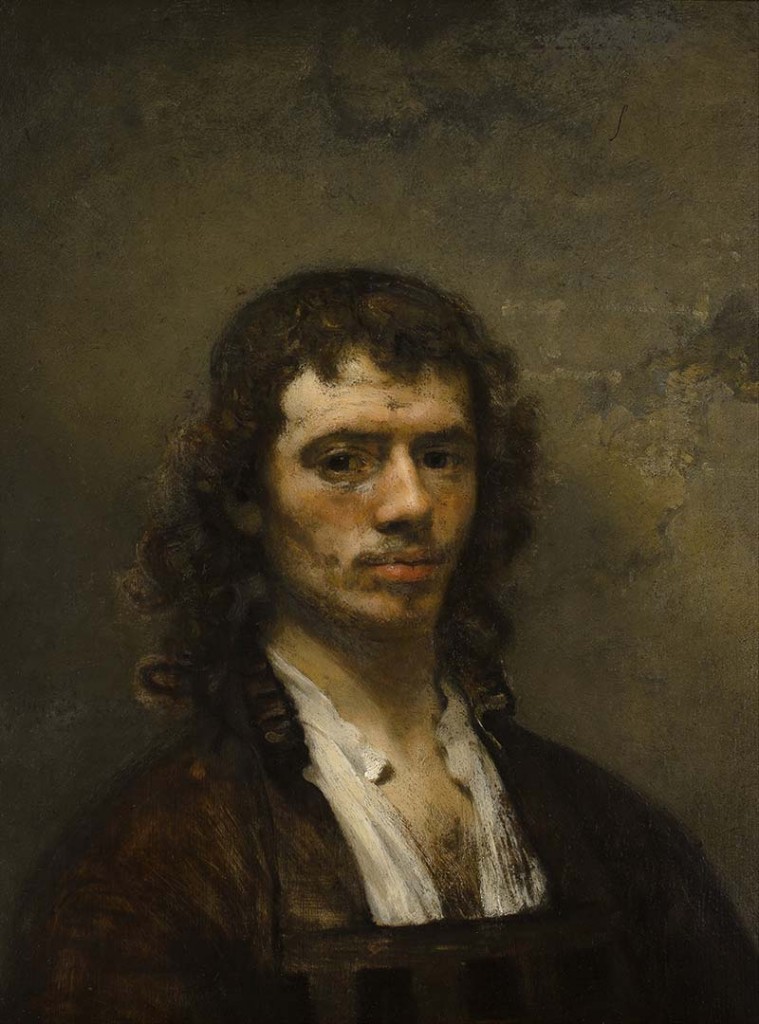
A comparison of Flinck’s work with that of other Rembrandt pupils in the early 1630s gives us an even better sense of how well Flinck adopted Rembrandt’s style in comparison with colleagues from the workshop. I use Carel Fabritius as an example, as he adopted Rembrandt’s style in a much different way. Fabritius’s Self-Portrait [Fig. 6] is about the same size as Flinck’s Self-Portrait at Age 24 [Fig. 5]. However, Fabritius has a much sketchier quality, while Flinck’s features are more smooth and realistic in tone. Fabritius uses dark, dry brush marks which give his figure a sketchy, less naturalistic texture. Fabritius also does not render his figures with the Rembrandtesque luminosity of skin as Flinck does, making the skin look a lot more matte. Though both portraits have a similar Rembrandtesque light source, the light in Flinck’s portrait achieves more depth than Fabritius’s, especially through the way it interacts with the hair and makes the thinner parts lighter, as Rembrandt does in his portraits. Fabritius also uses cooler tones in his color palette. Additionally, the composition of Fabritius’s self-portrait is different; the sitter sits lower lower in the frame and is perfectly centered. Finally, Fabritius’s costume is quite different than Rembrandt’s of Flinck’s. It is brown instead of black, the neck is cut differently, and it has a less luxurious appearance.
Despite huge efforts by connoisseurs, especially as part of the Rembrandt Research Project, Rembrandt’s paintings remain one of the most contested and controversial areas of modern connoisseurship.[ref]Scallen, Rembrandt, Reputation, and the Practice of Connoisseurship, 18.[/ref] The definition of connoisseurship is the practice of locating works of art in space and time, and attributing them to individual artists based upon stylistic analysis.[ref]Ibid., 15.[/ref] Connoisseurship takes many approaches, considering stylistic, technical, historical circumstances and the like. However even with multiple views, it is still hard to gain objectivity, even with the more scientific approaches of our modern age.[ref]Liedtke, Rembrandt’s “Workshop” Revisited, 50.[/ref] The problems of connoisseurship place the blame of the difficulty of attribution on Rembrandt’s role as a merchant, for teaching his students to paint so convincingly in his own manner.[ref]Ibid., 64.[/ref] And, although Rembrandt’s studio practice had a significant impact on and implications for connoisseurship, little information is available to illuminate it.[ref]Scallen, Rembrandt, Reputation, and the Practice of Connoisseurship, 77.[/ref] One challenge to Rembrandt connoisseurs is that there are no “telling details,” no formulae in his style, so scholarship has relied on data regarding signature, style, and quality to try to identify original Rembrandt works.[ref]Ibid., 33.[/ref] This lack of information was mostly because workshop practice depended on the customer’s demands.[ref]Wetering, Connoisseurship and Rembrandt’s Paintings, XVII.[/ref] This practice, paired with his students’ mastery of his own style, makes it hard to tell what exactly makes a Rembrandt authentic: is it the techniques, the colors, the form, the composition, or the combination of all these aspects?[ref]Sullivan, Out of the Shadows.[/ref] The viewer must thus be wary of autographs, signatures, and features in Rembrandtesque works.[ref]Liedtke, Rembrandt’s “Workshop” Revisited, 53.[/ref]
Modern connoisseurship has been aided in the difficulty of attributing works by Rembrandt by scientific advancements such as infrared reflectography, autoradiography, and more sophisticated pigment analysis. These methods combined with traditional visual analysis of style and technique have helped to make connoisseurship a more objective verifiable “science,” but only to a degree.[ref]Scallen, Rembrandt, Reputation, and the Practice of Connoisseurship, 325.[/ref] Connoisseurs still often fall back upon more subjective traditional techniques such as analysis of style and brushwork to determine authenticity.[ref]Sullivan, Out of the Shadows.[/ref] In the case of Flinck, one of the best ways to differentiate his work from Rembrandt’s has been to compare Flinck’s earlier paintings to his later ones, which he signed with his own name. Flinck’s manner of painting, his brushwork, his expression or lack of detail, and his capture of individual features have all helped in the identification process.[ref]A Corpus of Rembrandt Paintings III, 18-19.[/ref] One example of this is his soft rendering of hair. As opposed to Rembrandt, who chiseled the paint on the canvas to create bright defined hairs, as seen clearly in his 1628 Self-Portrait at an Early Age [fig. 7], Flinck painted feathery undefined locks, as in his Middlebury Portrait of a Man [fig. 1]
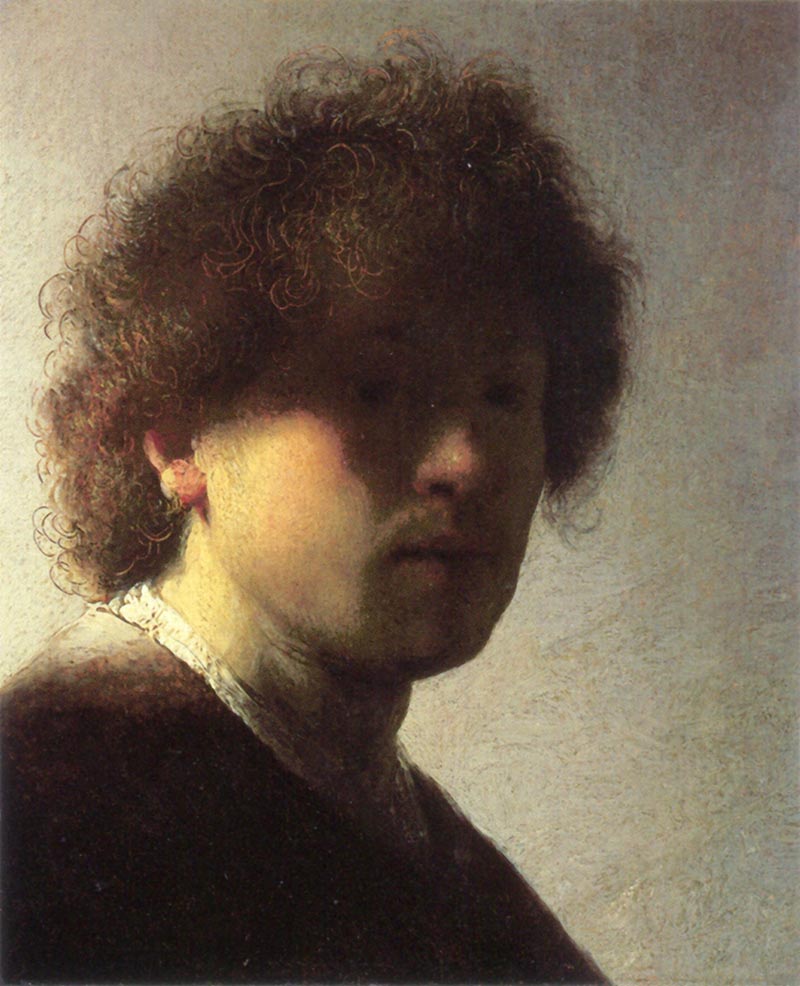
As connoisseurship practices have changed and evolved, many of the presumed Rembrandts have been reattributed to his students. In fact, the older view of Rembrandt’s oeuvre held by some of his most prominent connoisseurs—Smith and Bode for instance—was that Rembrandt executed his paintings without any assistance at all. This view remained in place until the 1960s, when it was revised by Horst Gerson and other scholars. Around this time, with increased knowledge about the function of Rembrandt’s studio, many of the previously designated “Rembrandts” became attributed to Flinck.[ref]Liedtke, Rembrandt’s “Workshop” Revisited, 51.[/ref]
Today’s connoisseurship is still certainly not devoid of mysteries; there are still many paintings which connoisseurs are unsure whether to attribute to Rembrandt or to Flinck.[ref]Schatborn, The Early, Rembrandtesque Drawings of Govaert Flinck, 15 and 29.[/ref] In addition, many of the attributions that have been made to Flinck are very speculative, hinging on hairsplitting analyses of many aspects, or based upon generalizations.[ref]Liedtke, Rembrandt’s “Workshop” Revisited, 52.[/ref] Examples of works that have been reattributed from Rembrandt to Flinck include Jacob and the Blood Stained Coat [fig. 8],[ref]R.R. Tatlock, Two Pictures from the School of Rembrandt (The Burlington Magazine for Connoisseurs, Vol. 39, No. 223: October, 1921), 195.[/ref] Kassel Portrait with Helmet [fig. 9], A Young Woman as a Shepherdess [fig. 10],[ref]Web Gallery of Art, “A Young Woman as a Shepherdess,” Biography, accessed 4/22/15, http://www.wga.hu/html_m/f/flinck/shepher.html.[/ref] and A Young Man Seated at a Table [fig. 11].[ref]National Gallery of Art, “A Young Man Seated at a Table (possibly Govaert Flinck),” NGA Online Editions: Dutch Paintings 17th Century, accessed 4/22/15a http://www.nga.gov/content/ngaweb/Collection/art-object-page.84.html.[/ref] The reattribution seems perhaps tenuous in works like Self-Portrait with Helmet, because of the sitter’s likeness to Rembrandt. Likewise A Young Man Seated at a Table reveals painting techniques which are used so similarly by both Rembrandt and Flinck. After being analyzed by connoisseurs in the Rembrandt Research Project, however, authorship of all these works was reassigned to Flinck.
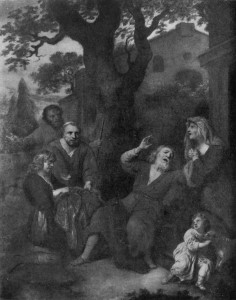
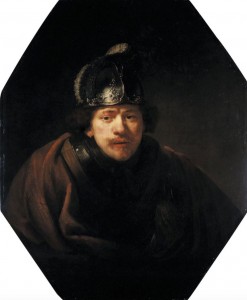
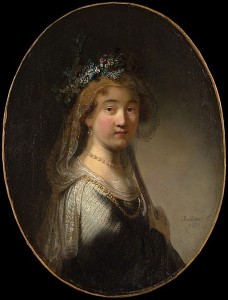
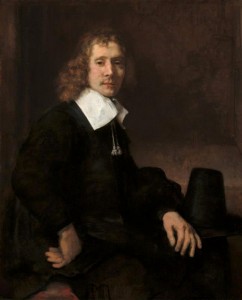
Throughout different periods in history, the group of accepted authentic Rembrandts has expanded and contracted, due to changing principals and techniques of connoisseurship. These changes in the attribution of Rembrandt’s paintings by connoisseurs has caused much controversy, especially stemming from the reattributions of the Rembrandt Research Project (RRP). For example, John C. van Dyck in the 19th century cut down the Rembrandt oeuvre severely.[ref]Scallen, Rembrandt, Reputation, and the Practice of Connoisseurship, 298.[/ref] Modern scholarship, including that of the RRP and independent connoisseurs, has again greatly reduced Rembrandt’s surviving oeuvre, which is now down to some 250-350 paintings.[ref]Ibid., 321.[/ref] In the 1980s, when the RRP published the first three volumes of their Corpus on Rembrandt’s works, heated debates arose regarding the their sometimes controversial findings.[ref]Ibid., 16.[/ref] One of the major concerns was that the change of authorship greatly reduced the monetary values of works formerly attributed to Rembrandt, which had an unsurprisingly negative effect upon their owners.
Portrait of a Man does not have an exact date—the Middlebury museum label says 17th century. I propose that Flinck painted it while still in Rembrandt’s workshop, between 1635 and 1636, and that Rembrandt oversaw the process. I make this speculation based partly on the fact that Flinck developed his own very different style shortly after leaving Rembrandt’s workshop, around 1643–1645, and did not continue to work in the Rembrandtesque style. More importantly, I base my argument on the strong Rembrandtesque style of the painting, as previously discussed, and as demonstrated by the details of the brushwork of various characteristics of the painting. To show the connection of the painting to the studio, I will compare Flinck’s style to Rembrandt’s and to the other works of other contemporary artists who apprenticed in Rembrandt’s studio at roughly the same time: in particular, Ferdinand Bol and Gerbrand van den Eeckhout.
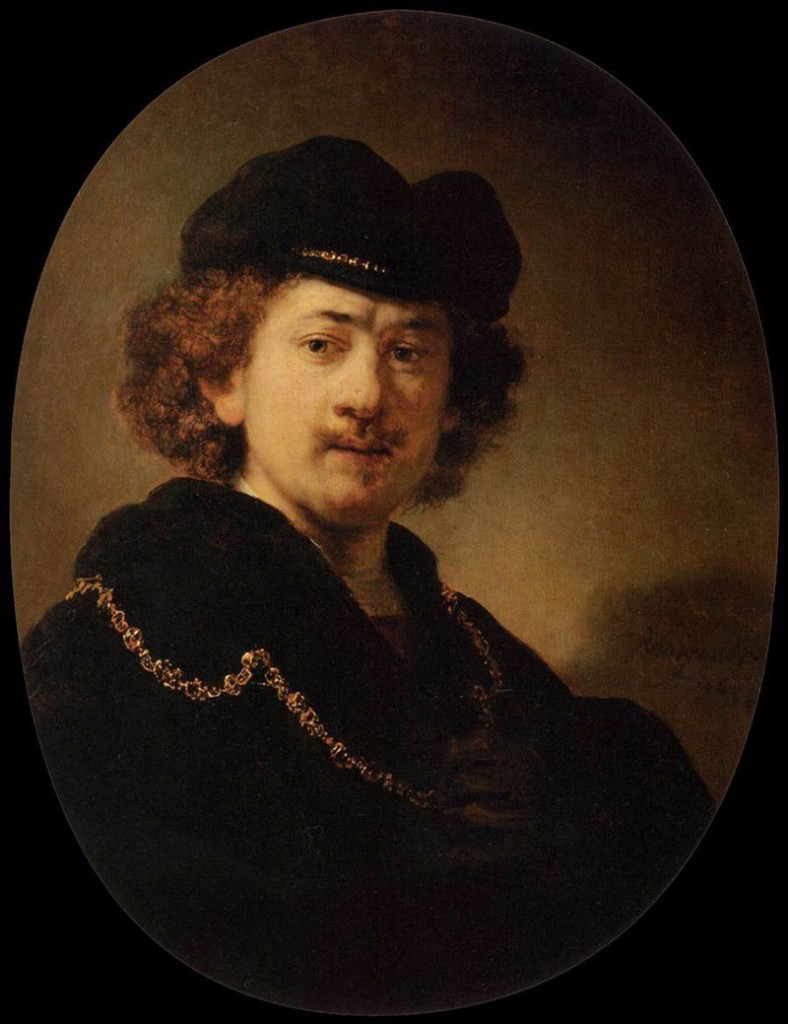
Compared to Rembrandt’s Self-Portrait in Cap, 70 x 54 cm, [fig. 12] Flinck’s painting is a bit larger, measuring 81 x 69 cm [fig. 1]. However, Flinck’s portrait’s composition emulates closely the early self-portraits by Rembrandt: the figure emerges form the left bottom corner in three-quarter view, occupying more than half of the surface. Flick even follows Rembrandt’s clothing: he sports a black beret which compliments his black velvety robes. The shadows and highlights in the velvet are treated similarly. The clothes of both figures have gold embroidery that shines out from the shadows, and they are wearing a thin white scarf with an almost dirty appearance. The back-lighting is also similar, as it illuminates mostly one side of the face and is masterfully reflected off the hair. While Flinck’s painting is somewhat larger—81 x 69 cm vs. 70 x 53 cm—a close-up of the portraits can still give us a sense of the luminosity in both the faces and the details of the clothing [fig. 14-15].

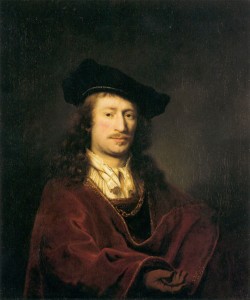
Both Bol and van den Eeckhout worked in Rembrandt’s studio at nearly the same time Flinck did, and their work in comparison to Flinck’s shows similarities in style which indicate their apprenticeship with the master and the master’s direction in their training. Bol started working in Rembrandt’s studio in 1636,[ref]Liedtke, Rembrandt’s “Workshop” Revisited, 63-4.[/ref] about the time Flinck left, and stayed there until 1643.[ref]Ibid., 68.[/ref] Similarly, Eeckhout likely worked in the studio alongside Flinck.[ref]Encyclopedia Brittanica, “Gerbrand van den Eeckhout: Dutch Painter and Poet,” last modified 8/5/2014, accessed 4/22/15, http://www.britannica.com/EBchecked/topic/179906/Gerbrand-van-den-Eeckhout.[/ref] Bol’s Self-Portrait at the Age of 30 [fig. 16], made around the same time in 1644, maintains Rembrandt’s portrait composition, though it is slightly more centered on the figure. Also, Bol’s painting—measuring 100 x 84 cm—is considerably larger than Flinck’s Portrait of a Man [fig. 1], which measures 81 x 69 cm. The gold-embroidered beret and the white scarf are employed as well. Although there is perhaps less luminosity in Bol’s portrait, the light source comes in from the side and illuminates the face in a similar way.
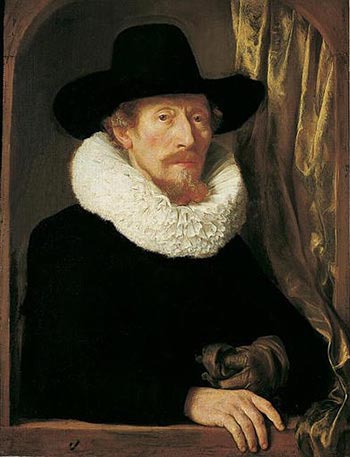
Compared to van den Eeckhout’s Portrait of the Father of the Artist [fig. 17], of which the dimensions are unknown, we see a similar composition and lighting, illuminating the face, slightly turned at an angle. Eeckhout also seems to have mastered the luminosity of the Rembrandt style, making the sitter’s face look slightly waxy and very realistic. The color palate is also very similar to Rembrandt’s and Flinck’s, as the figure has reddish hair and a fair, pinkish complexion. We see the play of light on the fabric of the curtains, emphasizing the texture of the silky material. Thus, the paintings share prominent qualities that are similar to Rembrandt’s works and were undoubtedly a result of the instruction of the master. The comparison of the paintings by the apprentices, all created while under Rembrandt’s supervision at roughly the same time in the studio, show a consistency in Rembrandt’s teaching methods which affirms that Flinck’s Portrait of a Man was also likely to have been made under Rembrandt’s instruction in the workshop.
The title of Flinck’s portrait is generic. But, based on an analysis of style and the sitter’s features, it is possible to determine that the painting may be either a self-portrait or a portrait of Rembrandt. However, to go even further, I propose that it is in fact a self-portrait of Flinck. I am basing this argument on the painting’s likenesses to other portraits of Flinck, and contrasting it with Flinck’s portraits of Rembrandt. I will make this argument by using paintings by both Rembrandt and Flinck to account for the variables of each artist’s style and how those variables might affect the likeness.
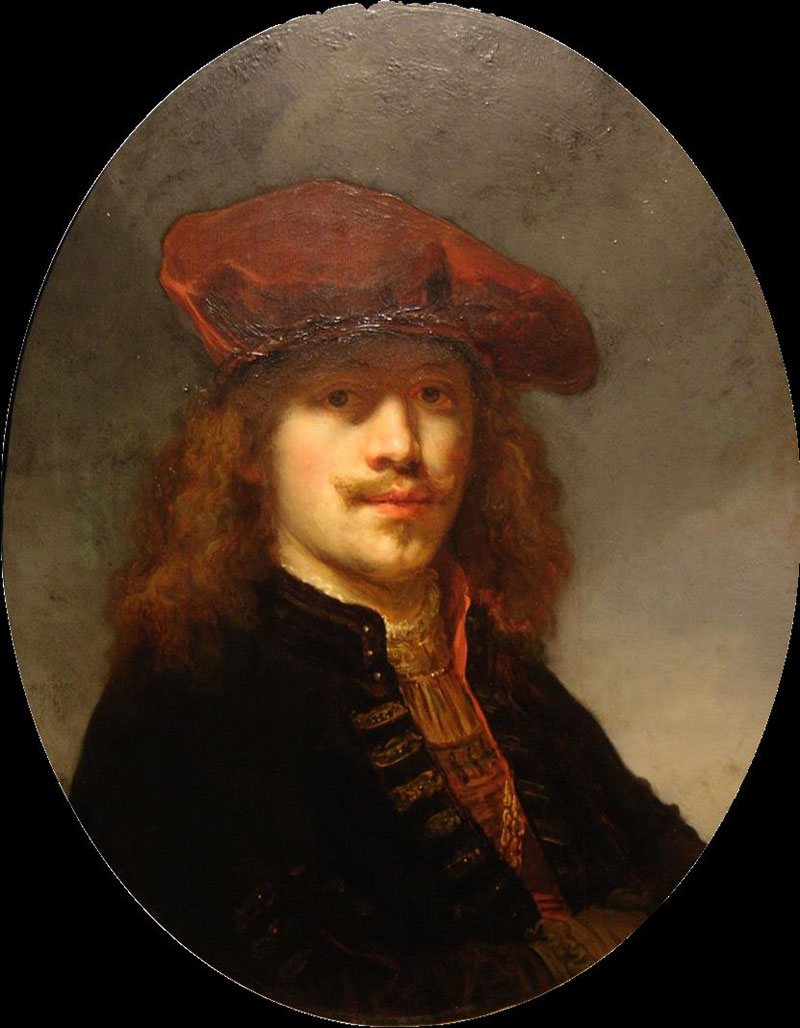
First, I consider Flinck’s self-portraits. Comparing Self-Portrait with Beret (66 x 51 cm) [fig. 18] to the Middlebury Portrait of a Man (81 x 69 cm), one notices that the hair in both is shoulder length and falls in gold-red curly locks [fig. 19-20]. The faces are both oval, tapering toward the chin. The only notable difference is that the sitter in the Middlebury portrait seems to have a bit chubbier chin. The skin tone in both is also very fair, with a translucent quality, and there is ruddiness in the checks and a bit of redness in the nose. The general color scheme of the paintings, especially of the features, is similar.
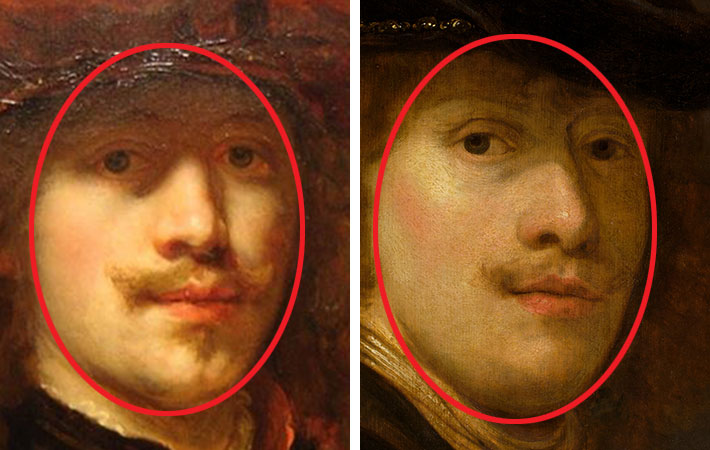
The shape of the eyes and eyebrows is also similar. [fig. 21-22] The brows arch evenly and thinly, and the eyes are almond-shaped and have a similar expression as they gaze at the viewer. The noses are both rounded at the ends and notably prominent. The lips are of a similar shape and color, with the top lip rising sharply in two high ridges. Finally, the mustaches of both sitters are also quite similar, with a wispy, not-yet-fully-developed quality, pointing upward at the edges. The youthfulness of the facial hair also suggests the sitter is likely not Rembrandt, who was nine years older than Flinck, but rather the youthful Govaert apprenticing in Rembrandt’s studio.
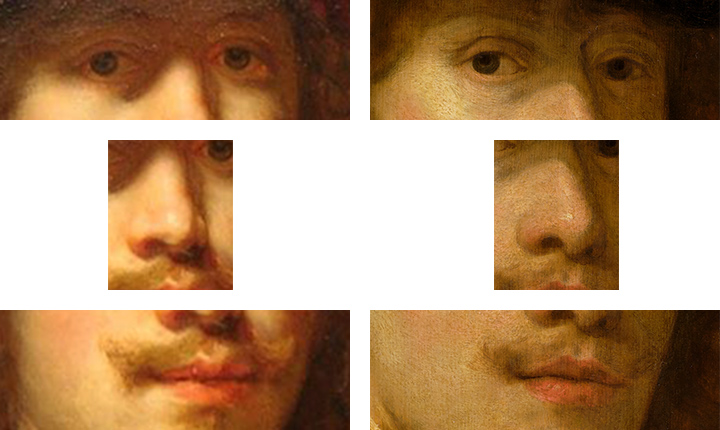
Secondly there are Flinck’s portraits of Rembrandt. One very interesting point here is that the facial features can vary a great degree. In Flinck’s Portrait of Rembrandt, 64 x 49 cm. [fig. 23], the figure strongly resembles Flinck’s self-portraits. In fact, the evidence coming from comparing the previous portraits by Flinck makes it seem possible that Moltke misattributed this painting as a portrait of Rembrandt, when it in fact may have been a self-portrait. Rembrandt as Shepherd with Staff and Flute [fig. 24], however, looks very convincingly like Rembrandt’s self-portraits, and in fact the painting used to be attributed to Rembrandt.[ref]Essential Vermeer, “Rembrandt as Shepherd with Staff and Flute,” Govaert Flinck, accessed 4/24/15, http://www.essentialvermeer.com/dutch-painters/flink.html#.VTq2VFPF8mV.[/ref] His face is rounder, and his hair curlier and darker. The eyes are darker and deeper set, and the eyebrows thick and straight. Even in a less Rembrandtesque painting, such as Portrait of Rembrandt, Half Length (dimensions unknown) [fig. 25], we see that stylistically it is rendered very similarly to Flinck’s self-portraits. [fig. 1] Furthermore, Flinck paints Rembrandt as having hair and skin more similar to his own. However, the shape of the face and the features remain markedly different than Flinck’s, and are consistent with Rembrandt’s features. The face is still much rounder, with deeper, larger, heavy-set eyes and bushier brows.
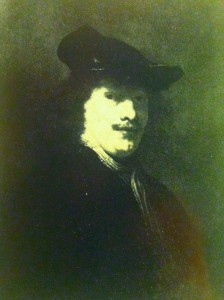
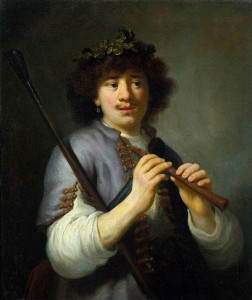
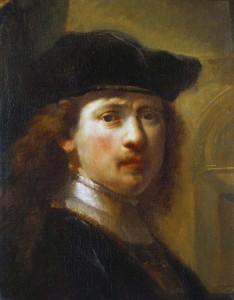
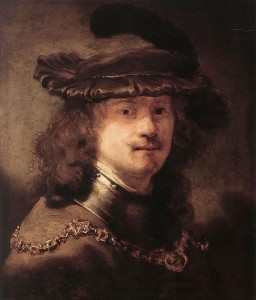
Another important portrait to consider is Flinck’s 1633 Portrait of Rembrandt [fig. 27], which is much smaller than his Portrait of a Man [fig. 1], measuring 57 x 46 cm compared to 81 x 69 cm. Here, Rembrandt’s likeness is painted more similarly to Flinck’s likeness than in any of Flinck’s other portraits of Rembrandt. This painting was fairly recently reattributed to Flinck, and was previously thought to be by Rembrandt. The date of the painting also places it very early in Flinck’s apprenticeship with Rembrandt.
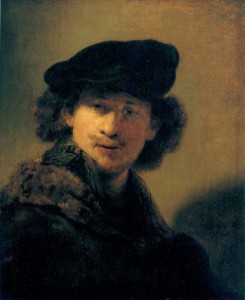
The third comparison with Middlebury’s Flinck portrait are the self-portraits by Rembrandt, for example Self-Portrait in Cap [fig. 12] and Self-Portrait in a Cap and Fur-Trimmed Coat [fig. 29]. The features Rembrandt depicts are very consistent, here and elsewhere, and do appear to belong to the same person. These characteristics are consistent even when the costume and portrait size (here 81 x 69 cm vs. 58 x 47 cm) differ. Very importantly, Rembrandt never paints a self-portrait with the features that Flinck uses to depict himself, as in Portrait of a Man. There is no self-portrait by Rembrandt which depicts himself with the thinly shaped face, red hair and skin tones—all the specific features which are markedly present in Flinck’s self-portraits. This designates Flinck with a distinct likeness and suggests that the features must be unique to him. Unfortunately there appear to be no portraits by Rembrandt of Flinck, though it would be interesting to see whether Rembrandt painted Flinck differently than he painted himself. A comparison of the three types of paintings together helps show the differences of likeness between them [fig. 30]. Thus, because Flinck seems to have developed a unique likeness which he uses mostly in his self-portraits, I am drawing the conclusion that the type is in fact his likeness, making his Portrait of a Man—which clearly displays those features—a self-portrait.
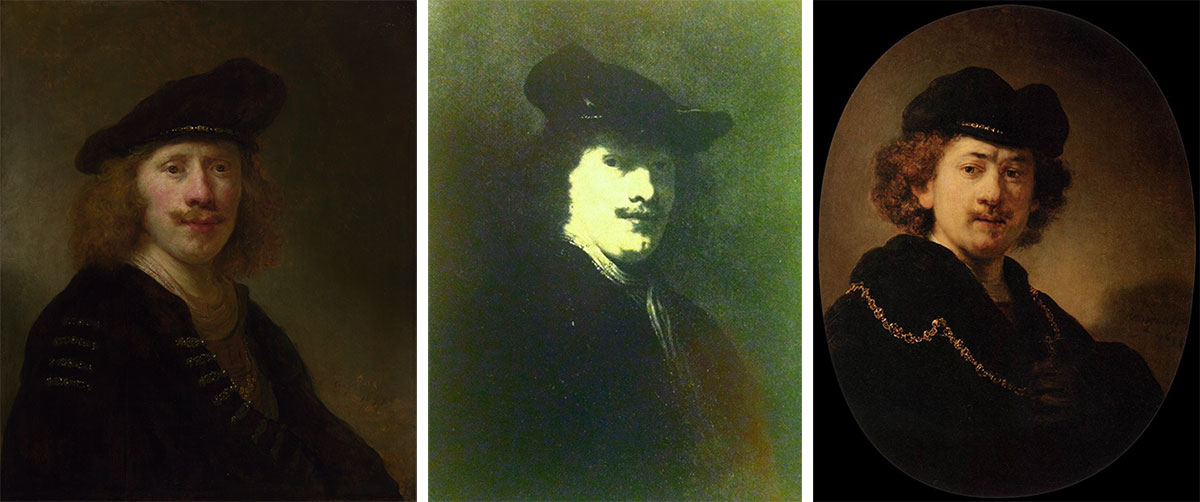
Conclusion
In dealing with Flinck’s Portrait of a Man, one must consider the unique enterprise of Rembrandt’s practice, as it obscures and adds to the complexity of determining who the sitters might be and, in some cases, even who the artist might have been. It is also important to consider the studio context because it undoubtedly influenced the creation and the purpose of the painting. It was made to be part of the Rembrandt enterprise: to look like a Rembrandt and to be sold as such, thus disseminating Rembrandt’s style even further. One reason this painting so successfully emulates Rembrandt’s style is that Flinck was one of Rembrandt’s best students, mastering “the Rembrandt.” He was so good, in fact, that many of his paintings have been mistakenly attributed to Rembrandt. However, there are certain characteristics in Flinck’s later signed works which have helped connoisseurs attribute his early Rembrandtesque paintings to him. The trouble with attributions of Rembrandt’s oeuvre have caused controversy among connoisseurs, but many of Flinck’s works have been correctly attributed because Flinck was one of Rembrandt’s best and most well-known students, and he went on to become a master painter himself.
By drawing upon the highly Rembrandtesque composition and style of Flinck’s Portrait of a Man, as well as the differences between Flinck’s and Rembrandt’s likenesses as rendered by both artists, I conclude that Flinck painted his portrait while apprenticing at Rembrandt’s studio, under Rembrandt’s supervision, and that the unknown subject of the portrait is in fact Flinck himself. Rembrandt was known for dressing up and painting himself in historical costumes,[ref]Manuth, “Rembrandt and the Artist’s Self Portrait: Tradition and Reception,” 40.[/ref] thus emulating his artistic predecessors. He acknowledges the artistic precedents he is following, and he also celebrates himself in a dual manner: by giving himself the credit of the masterful painting, and by making himself the subject of the masterpiece. By creating his Portrait of a Man, Flinck seems to be following Rembrandt’s style of rendering a self-portrait, but instead of painting Rembrandt, he inserts himself into the tradition.
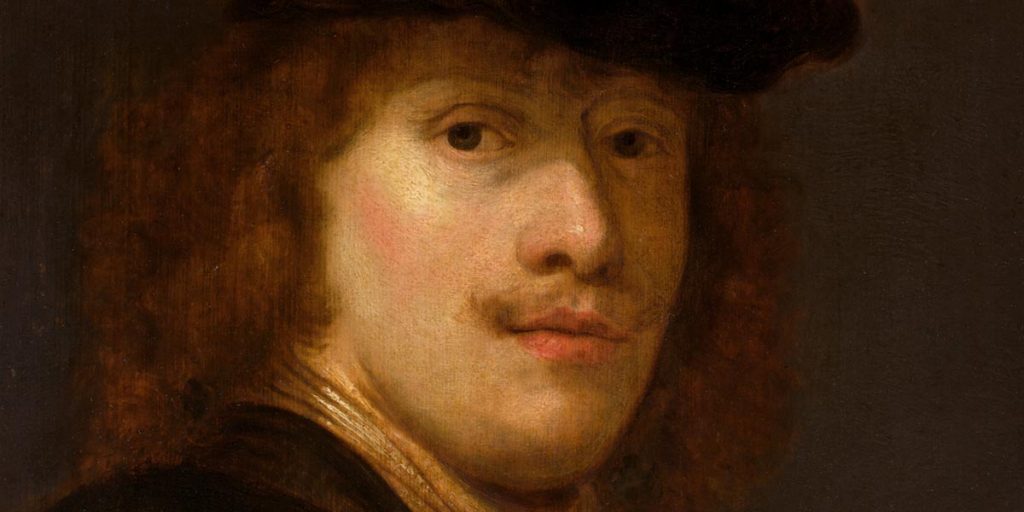
Complimenti pr le vostre dettagliate notizie storiche artistiche.
grazie
Alfredo Verdi Demma
alfredoverdidemma.com